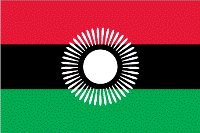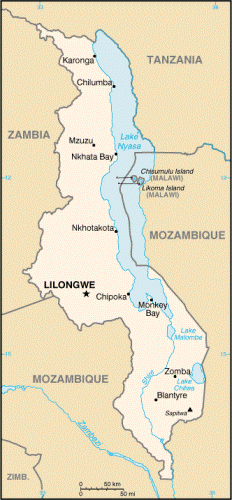Malawi is a landlocked country located in West Africa, and is bordered by Zambia to the east and Mozambique to the west and north. The total area of the country is 118,484 km2, and is one of the most densely populated countries in the world with a population of 16,323,044 as of July 2011. The country’s climate is mostly sub-tropical.
 |
The national flag of Malawi.
Image Credits: CIA Factbook |
Malawi gained independence in 1964 and ever since faced many challenges including population growth, developing a market economy, upgrading educational set ups, growing pressure on agricultural lands, environmental issues, corruption, shortage of foreign exchange, and rapid spread of HIV/AIDS. The nation’s economy depends a lot on the economic assistance from the World Bank, the IMF, and donor nations. The GDP of Malawi as of 2011 was $14.08 billion.
Malawi has abundant natural resources including limestone, and unexploited deposits such as uranium, coal, and bauxite. Majority of the country’s mining and mineral processing operations, especially the Mchenga coal mine, the Kayelekera uranium mine, the Nyala ruby and sapphire mine and the cement plants, are privately owned.
Overview of Resources
Malawi produces cement, coal, crushed stone, dolomite, kaolin, lime, limestone, and sulfuric acid mainly for domestic consumption. The country exports uranium, bentonite, gemstones such as garnet, ruby, amethyst, sapphire, and tourmaline, and ornamental stones such as rose quartz and agate. In 2010, the country produced 1% of the world’s uranium.
Malawi’s production statistics as of 2010 are as follows:
- Uranium increased by 587%
- Sulfuric acid increased by 493%
- Ornamental stone increased by 80%
- Coal increased by 34%
- Limestone for use in cement industry increased by 22%.
Metals
Globe Metals & Mining Ltd. of Australia along with Thuthuka Group of South Africa conducted a feasibility study to develop a new mine at Kanyika in 2011. The companies planned to produce 3,000 Mt/yr of niobium, 194 t/yr of tantalum pentoxide, and 117 t/yr of uranium oxide starting 2012 based on the feasibility reports. Globe also has plans to mine zircon. The new mine’s life was estimated as more than 20 years.

The map of Malawi. Image Credits: CIA Factbook
Industrial Minerals and Gemstones
Portland Cement Company Ltd., a subsidiary of LaFarge S.A. of France, produces cement using imported gypsum and clinker. The cement plant owned by Shayona Cement Corp. had a 60,000 t/yr capacity. Plans to expand its capacity are underway. Zagaf Cement Sales had started construction of a new cement plant in 2010 at Mangochi with plans to complete it by 2013.
Rare-earth elements are found at the Kangankunde deposit of Balaka. The deposit accounted for 2.53 Mt at a grade of 4.24% rare-earth minerals. Mkango Resources of Canada has entered the Malawi mining sector to explore the significant amount of high grade rare earth minerals discovered at Songwe hill in Phalombe district. Rare earth deposits can also be found in Tundulu and Songwe in Phalombe, Kangankunde in Balaka district, and Lake Chilwa island in Zomba districts. The rare earth deposits are mostly carbonatite and alkaline-based. Experts believe that other rare earth types such as placer and hydrothermal iron are also found in the country.
Fossil Fuels
Malawi’s first uranium mine was developed by Paladin in 2009 at Kayelekera. In 2010, the production of uranium oxide increased to 790 t from 115 t in 2009. The mine’s full capacity was estimated at 1,500 t/yr. Almost 10% of Malawi’s exports in 2010 consisted of uranium.
Increase in the domestic consumption of coal especially by the brewery, cement, and tobacco industries resulted in Malawi’s coal production to increase from 59,201 Mt in 2009 to 79,186 Mt in 2010. The government has plans to develop a new coal-fired power station with a capacity of 300 MW.
Investment
Malawi’s department of Mining and Geological Survey has announced that the state campaign that was launched to attract mining investors was successful, with major international mining companies signing up to invest in production and exploration operations in the country.
To further boost investments, the government will need to resolve issues such as unreliable power sources, poor telecommunications infrastructure, and water scarcity. The delay in sorting these issues brought down the investment by 23% in 2009 and this situation continued in 2010 as well.
Australia based, Paladin Africa’s Kayerekera Uranium Mining have already started operations in the northern Karonga district mine. Another big Australian mining company, Globe Metals and Mining, has plans to produce 55.3 million Mt of ferroniobium metal from a mine in the Kanyika hills in Mzimba district in 2014.
The Malawi government has granted an exploration license to UK-based Surestream Petroleum to invest US$30 million for a four-year period to search for oil on Lake Malawi.
The government of Malawi is taking efforts to enlighten the global mining community about the country’s mineral wealth by partnering with the World Bank to launch the Malawi Mining Growth Project through which the geology of the country will be remapped so as to provide the latest information on potential mineral deposits.
Thanks to the efforts by the government to promote the mineral industry, the mining sector of Malawi can hope for a bright future.
Disclaimer: The Author of this article does not imply any investment recommendation and some content is speculative in nature. The Author is not affiliated in any way with any companies mentioned and all statistical information is publically available.
Sources and Further Reading
Disclaimer: The views expressed here are those of the author expressed in their private capacity and do not necessarily represent the views of AZoM.com Limited T/A AZoNetwork the owner and operator of this website. This disclaimer forms part of the Terms and conditions of use of this website.